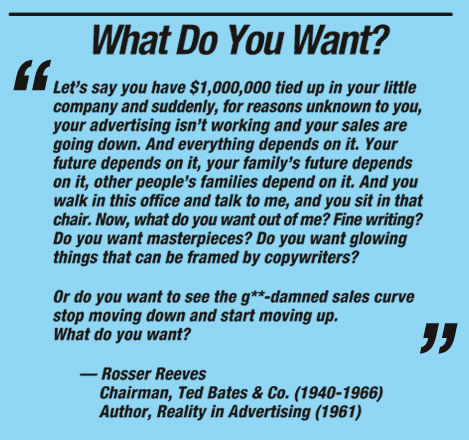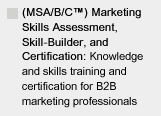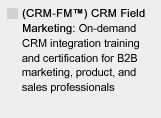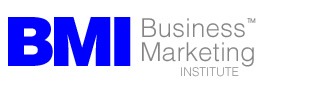MAKE SURE YOU CONTINUE TO RECEIVE EACH ISSUE OF TUESDAY MARKETING NOTES—CLICK HERE TO RENEW YOUR FREE SUBSCRIPTION
Sales Turnaround 101:
What To Do When Your Marketing Program Hits The Wall
by Eric Gagnon

It’s been said that failure is a better teacher than success. As marketing professionals, we all know we’ll experience failure in our marketing careers: An advertising program that generates few sales inquiries. A mailing that pulls in lower than expected response. Or, a change in market conditions, such as a competitor’s new product introduction or price cut, that puts your entire marketing program at risk.
For marketing professionals, failure comes with the territory, but it can also reveal the changes that point the way to a much better result on your next attempt. Nothing can be done without the risk of failure, and since failure is a by-product of doing, not failing usually means not doing.
Often, the result of a marketing project is neither a clear-cut success, or an outright failure. Sales response from your ads or mailings will land somewhere in the “grey middle,” giving you a result that is neither a great success, nor a clear-cut failure.
In both cases, your ability to identify the causes of poor sales response, your marketing execution skill, and your mindset and attitude can help you turn your marketing program around.
Obviously, market testing (covered in previous TMN articles) minimizes the cost of failure, and this is the reason you test. But failures in marketing occur both in testing and your ongoing marketing program, and this week we’ll cover some techniques for identifying causes of poor sales due to faulty marketing programs, and how you can turn these around.
Stay Calm, and Examine What Went Right
The first thing you need to do when you receive news of a bad result on a marketing project is: Stay calm. Ignore the other members of your team who may be running for the tall grass; fear and panic are a natural reaction to bad news, and neither helps you find a way out of the problem.
The second thing to do is carefully examine your marketing project, and find out what went right with it. For example, a response to a mailing may be a disaster, but the prospects who did respond may be from companies that, in themselves, might represent a new market niche that could be targeted more effectively in the next mailing. Also, for one reason or another, an ad or mailing might pull significantly more response from one publication or list than in other publications or lists. Try to find out why.
Where everyone else is wondering what went wrong, you should look through your results to see any areas where things went right, and reason out why this happened.
Talk to the Prospects Who Did Respond
Talk to the prospects who did respond to your failed ad, mailing, or other marketing project. Prospects will tell you what it was in your sales copy, product features, and call-to-action that motivated them to call your company, how they buy products such as yours, and how they think you could have done a better job of selling to people like them.
This often leads to valuable insights to help you change the ways you are talking to prospects, the media you’re using to talk to them, the offers you’re making to them, or changing the types of prospects, by job title or function, you should be talking to in your marketing program.
Leading Causes of Failure in Marketing Programs
Marketing projects and programs fail due to one or more of the following reasons:
1.) Poor marketing presentation;
2.) Poor prospect targeting or selection;
3.) Poor marketing execution:
4.) Other problems that may or may not be solved by better marketing skill
Poor Marketing Presentation
Weak sales copy and marketing deliverables are the main cause of poor sales response in marketing projects. By examining results and talking to prospects who did respond—or ones that didn’t—you can identify ways the content and presentation of your ads, mailings, Web site, and other deliverables can be improved on your next revision.
Problems in presentation are problems of clarity or boldness: Either the words and meaning of the content of your deliverable haven’t been communicated as well as they should be (clarity), or they haven’t been presented forcefully enough (boldness)—or both. Prospects aren’t clear on what your product is, and what it can do for them, or you aren’t making it easy enough for them to see why they need your product.
Main benefit is missing or not recognized by prospects: Most often, companies don’t lead with the major reason why the prospect should buy their product. They rely on a “clever” advertising approach that leads with a silly visual, a play on words, or other irrelevancy that doesn’t get to the heart of what a busy reader wants to know about the product, now.
Also, sales benefits may be used that are not recognized by readers as being relevant, useful, or compelling to them. If you’re talking about how your product’s high-tech coatings reduce wear, but what your prospects really want is to cut their energy costs, then you should be talking about how much your product’s new thermal insulation reduces their heat loss, and how much they’ll save.
Product information gaps: Your sales copy may not be giving readers the answers to the mental questions they’re asking about your product, and these gaps may be dramatically reducing sales response to your marketing program. You’ll often find this out when they ask your sales reps the following types of questions over and over:
• Major functionality question: “How does your product work?”
• Common product misconception clarified: “Do I have to do such-and-so to use your product?”
• Major application question: “Can your product do ___________?”
• Compatibility with another commonly-used industry product or service: “Is your product compatible with [well-known product, system, standard, or process] ?”
• Common feature question: “Does your product have [feature ‘X’]?”
For every prospect who asks you one of these questions, there are probably six others who’ve already asked and answered the same question, but not in your favor. These product information gaps are easy to close, by revising sales copy, and adding FAQ and Q & A flyers and sidebars to your marketing deliverables. The more of these questions you answer for the prospect, the more you’ll clear the field for your company’s sales reps by allowing them to handle the more complex or difficult questions their prospects have about your product.
No promotional offer or call-to-action: Once you have the prospect’s attention, and you’ve given them the essential benefits, features, and other details of your product, give them a compelling reason to buy, or to follow up with your company, right now. A discount savings offer, a free trial, a product bonus, free demo or any other inducement to call your company’s sales rep now can often be the make-or-break difference in the profitability of any promotion.
Also, make it clear to readers what you want them to do next if they’re interested in your product: Call your rep, contact a distributor, visit your Web site, etc., and make sure your company’s phone number and Web address is nice, big, and readable on all of your ads, mailings, Web pages, etc. Simple stuff, but you’d be surprised how many times companies drop the ball on this one.
Poor Targeting or Selection
Sometimes you’ll discover that you are marketing to the wrong prospects, by job title or responsibility, or trying to sell your product in what turns out to be the wrong market. This is something you’ll learn only after running a market test—which is, of course, the reason you’re testing in the first place.
Again, talking to prospects who’ve responded to your ads, mailings, or Web sites will tell you if these prospects are the people who should be receiving your mailings, or if you should be targeting prospects with different job titles or functions inside the company. If poor prospect targeting is a problem, your company’s sales reps will tell you they keep being referred to someone else at a company when they make their follow-up calls; maybe that “someone else” is the person you should be trying to reach.
Examples of problems related to poor targeting include selecting poor-quality mailing lists, and failure to obtain or capture telephone numbers or e-mail addresses in your mailing projects, so that your company’s sales reps can follow up with prospects who receive your mailings.
Poor Marketing Execution
Next to presentation and prospect targeting, poor marketing execution is a major cause of failed or underperforming marketing programs: Ads don’t get placed to meet publication deadlines for important promotions, delays in mailings create missed selling opportunities, late Web site launches, and countless other delays, foul-ups, or omissions that kill your marketing program in a death by a thousand cuts.
Practicing competent, timely, effective marketing execution is your responsibility as a marketing manager, agency professional, or consultant. If you’re a marketing manager, it’s up to you to know enough about the process of execution for every aspect of your marketing program to keep it on track; this is not the responsibility of your printer, Web producer, copywriter, consultant, or other downstream member of your marketing team. The responsibility is yours.
Most outside agency people and consultants will tell you they have more respect for a client marketing manager who has hands-on knowledge of the range of marketing projects being run in the marketing program. The marketing manager’s knowledge instills respect for the process of marketing execution, keeps projects running smoothly and on time, and prevents every marketing project from becoming a last-minute fire drill due to the manager’s poor grasp of marketing execution.
Respect for the process by the marketing manager down the line breeds respect for the marketing manager back up the line by the other members of your marketing team, inside and outside your company.
Fortunately, for the competent and the willing, poor sales response due to poor marketing execution is one of the easier marketing problems to solve. Marketing professionals can always learn better skills; all it takes is a willingness to stay engaged to the process, a focus on what’s important—getting the mailing out on time, instead of messing around with the trivial stuff, like whether the blue on the brochure should be PMS 294 or 301—and accepting responsibility when things go wrong.
Other Problems You May (or May Not) Be Able to Solve With Marketing Skill
Sometimes the problem with your product’s poor sales is the product: Your company’s product may be overpriced, it may have too many features that confuse prospects, or may lack features that are important to prospects. And, let’s face it, your market may also be telling you that your company’s product doesn’t measure up to the competition.
Some new, innovative products may be way ahead of their market, in that they require prospects to change their job processes, or the ways they do business. Paradigm-breaking products are often a tougher, slower sell.
These product-related problems can be solved, to some degree, by the application of clearer presentation or better marketing skill. However, this is not always the case, since better marketing skill can rarely save a bad product, and, if your product is a paradigm-breaker, you may not be able to get your prospects to change they way they’re doing business.
The important thing is to recognize when you have a problem that can be solved by better marketing, and when the problem is the product, which must be changed. Product-related sales problems often involve making changes to the product to enhance its marketability: Removing unneeded features which unduly raise the product’s price, or are unwanted by prospects, improving or modifying the product to meet the applications your prospects tell you they want to use your product for, instead of selling the feature set your company’s product engineers think your prospects need.
Where the problem is marketing-related, your ability to make the required changes to the deliverables, methods, and media in your marketing program to respond to necessary product changes can get your product, and your marketing program, back on track. Here is yet another situation where your (and your marketing team’s) ability to execute well means all the difference between success and failure.
There is Always One More Thing You Can Do
Never forget that when something bad happens to you, your response to the event ultimately determines the final result, and reveals the solution, if one can be found.
Also, remember the words of Lt. General Harold G. (“Hal”) Moore (Ret.) who, as an American commander, successfully led his 395 men against 2,000 elite North Vietnamese Army troops during the battle of Ia Drang, the first major battle of the Vietnam War.
His advice to his men: “Don’t say ‘there’s nothing you can do.’ There’s always one more thing you can do.”
Next to a positive attitude, action is the antidote to any adverse major marketing factor you can’t control. Never give up.
If you realize that you are operating inside a negative environment and, after thoughtful analysis you conclude there is nothing wrong with either your product or your marketing program—change your environment.
Break your conception of your product, and think about new ways it can be sold. Do this by continually testing new markets, and making changes to your product to make it more attractive to prospects. Keep working all of your options, and thinking of new ones.
Even if you can’t find a solution to your crisis, the mere fact that you are taking action changes your environment, and this change creates a condition where solutions begin to reveal themselves.
Taking action always creates new options. And these new options often lead you to more effective ways to selling your company’s product: A quick test mailing to a totally new and different market or industry that generates sizeable interest and response; a cheaper spin-off of your product that makes its price point more affordable, tripling your sales volume overnight; an overnight change to your pricing, or adding a new distribution partner.
Keep blasting away and the breaks will come. In business, success often comes not to the luckiest, the richest, or the smartest, but to those who can hold on the longest.
Life, and business, is not a still life painting in an art gallery. It’s a constantly changing environment: Things change, for better as well as for worse. Dumb luck works just as well as good luck, but you’ll never find either one if you give up.
Taking action helps you—and your marketing program—survive to face another day, and the day after that. And every day, the mere fact that you are alive and “in the arena” with your marketing program is another day closer to the day that things break in your favor. You’ll only fail if you quit—so don’t quit!
There is always something you can do.
Comments? Questions? Send them to me at: eric@businessmarketinginstitute.com
Eric Gagnon (eric@businessmarketinginstitute.com), a director with the Business Marketing Institute, is author of The Marketing Manager’s Handbook and The CRM Field Marketing Handbook.








